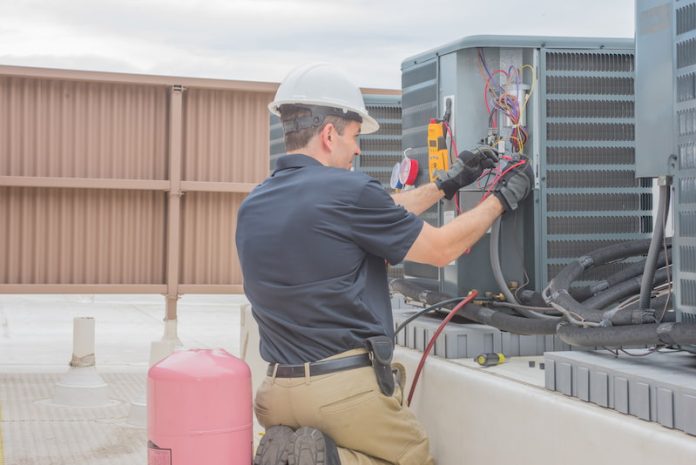While a small commercial HVAC system can be installed with one or two people in a home, a commercial HVAC installation is another matter entirely. These large units are designed to provide central heat and air for large buildings with multiple rooms and users. As a result, they are heavy, large in size, and require industrial grade electrical connections for power. Frequently, they have to be lifted by crane onto the building where they will be installed, and then positioned in place with mechanical help as well. It’s definitely not a simple haul-in and drop operation.
A good amount of planning goes into the project as well. In a sense, a commercial unit installation is very much a construction project. It includes multiple players for scoping, site evaluation, testing, transport, crane lifting, installation, connection, quality control and final customer walk-through and training.
Table of Contents
Professional Help is a Must
Unless a business or organization has dedicated and trained HVAC staff on hand, a professional HVAC installation is going to be a must for any kind of commercial HVAC installation on a building rooftop. That starts with a full evaluation of the site and an examination of the existing system if one is installed already.
From the site review, the right model is determined upon agreement with the client, and flow tests are examined to confirm what modifications will be needed to realize an optimum performance. All of these services can be packaged and handled by a professional commercial HVAC team when the AC unit package itself is acquired.
Training and experience of commercial rooftop HVAC replacement services are key factors in successful installation as well. Companies that have a solid track record of rooftop industrial installation are familiar with the latest models, system requirements, what is required for connections and most importantly, how to troubleshoot issues as they come with these projects.
Optional Benefits With Modern HVAC Models
A good amount of attention now focuses on making buildings as green as possible, supporting sustainability impacts on the local environment. With many choices today, sustainability features are being included, specifically in reducing the amount of by-product emissions that exit operating industrial and commercial AC units. Facility owners will now have a far larger selection of choice in this arena, which can count towards meeting local regulations for cleaner operations as well as for marketing goodwill with the local community too.
Testing and Performance Runs
An installation doesn’t end with the connection and first run of the system. Test runs, performance windows and monitoring should all be expected with a commercial AC acquisition and installation. More than one accident has occurred thanks to an improper installation or a faulty part. Active monitoring makes sure these issues are caught right away after a new installation and addressed before they become a bigger problem, like a facility fire, for example.
Focus on Warranty and Service Support Too
Any commercial HVAC, whether rooftop or ground, should have full warranty protection on the equipment from the manufacturer. Facility management should also closely consider the engagement of a support plan and scheduled review to make sure everything with the new AC system is running correctly and goes through scheduled maintenance. By having a professional service apply the checks and upkeep, the right parts, evaluation, experience and observation are applied. This has consistently contributed to avoiding costly repairs over the life of a commercial system as well as catching problems before they grow bigger.
Well-maintained commercial AC systems on building rooftops produce the longest lifecycle performance model after model, especially when consumables are actively changed and the system is kept clean and in operating order versus being neglected.













